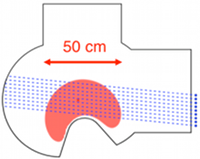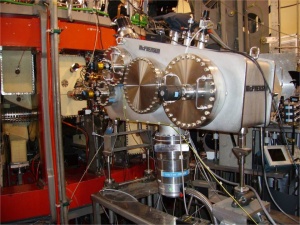TJ-II:Spectroscopy: Difference between revisions
No edit summary |
(Updated reference links) |
||
| (18 intermediate revisions by 4 users not shown) | |||
| Line 1: | Line 1: | ||
== Multichannel system == | |||
[[Image:spectrometer-setup.png|frame|Observation geometry of the nine-channel high-resolution spectroscopic diagnostic system]] | |||
[[TJ-II]] disposes of a nine-channel, high-resolution, spectroscopic diagnostic system. This system is currently being used to measure [[impurities|impurity]] ion temperature and poloidal rotation using passive emission spectroscopy. The principal features of the diagnostic include independent focusing of its channels, high sensitivity for performing Doppler measurements in plasmas, as well as a flexible and fast in-house-developed software program for performing integrated data reduction and analysis. | |||
<ref>[http:// | <ref>A. Baciero et al, ''A multi-channel spectroscopic system for measuring impurity ion temperatures and poloidal rotation velocities in TJ-II'', [[doi:10.1063/1.1326008|Rev. Sci. Instrum. '''72''' (2001) 971]]</ref> | ||
<ref>[ | <ref>B. Zurro et al, ''Comparison of Impurity Poloidal Rotation in ECRH and NBI Discharges of the TJ-II HELIAC'', [http://www.new.ans.org/pubs/journals/fst/a_1264 Fusion Science and Technology '''50''', 3 (2006) 419-427]</ref>. This experimental system has also been used to measure proton rotation using spectral line emission from excited fast neutrals created from inner core plasma protons via charge exchange transfer reactions. <ref>B. Zurro et al, ''Investigation of proton rotation measurements using hydrogen line wings in the TJ-II stellarator'', [[doi:10.1063/1.1537035|Rev. Sci. Instrum. '''74''' (2003) 2056]]</ref> | ||
== Toroidal rotation measurement == | |||
[[File:TJ-II McPherson.jpg|300px|thumb|right|The VUV spectrometer on TJ-II]] | |||
A method for measuring absolutely calibrated toroidal rotation velocities consists of simultaneously recording the emission lines from the plasma and from a calibration lamp by means of a double fiber-fiber guide. | |||
<ref>D. Rapisarda et al, ''Novel passive spectroscopy system for absolutely referenced plasma rotation measurements in clean plasmas'', [[doi:10.1063/1.2185507|Rev. Sci. Instrum. '''77''' (2006) 033506]]</ref> | |||
The system has been mounted at φ = -9.45° ([[TJ-II:Sectors|sector]] D8) and | |||
φ = 170.56° ([[TJ-II:Sectors|sector]] B8). | |||
== VUV spectroscopy == | |||
A vacuum ultraviolet spectrometer has been operated on TJ-II since 1999. It is an f/10.4 1 m normal-incidence vacuum spectrometer equipped with interchangeable 1200 and 3600 lines mm<sup>-1</sup> gratings and a back-illuminated CCD camera with 400 × 1340 pixels (20 × 20 μm<sup>2</sup>). The instrument covers the wavelength range from ~20 to ~300 nm. It has been used to perform spectral surveys (identify and follow the evolution of plasma [[impurities]]), to obtain impurity ion temperatures, and to perform specialized studies (e.g. study fast oxygen ions present in plasmas during the neutral beam injection heating phase). | |||
<ref>K.J. McCarthy, B. Zurro, R. Balbín, A. Baciero, J. Herranz, and I. Pastor, ''Results of an experiment relating apparent Doppler ion temperatures with non-thermal velocities in hot-fusion plasmas'', [[doi:10.1209/epl/i2003-00476-x|Europhys. Lett. '''63''' (2003) 49]]</ref> | |||
<ref>K.J. McCarthy, M. A. Ochando, F. Medina, B. Zurro, C. Hidalgo, M. A. Pedrosa, I. Pastor, J. Herranz and A. Baciero, ''A First Study of Impurity Behavior During Externally Induced Radial Electric Fields in the TJ-II Stellarator'', [http://www.new.ans.org/store/j_548 Fusion Sci. & Tech. '''46''', 129-134 (2004)]</ref> | |||
<ref>K.J. McCarthy, V. Tribaldos, J. Arévalo, and M. Liniers, ''The detection of fast oxygen ions in neutral beam-heated plasmas of the TJ-II stellarator using spectroscopy methods'', [[doi:10.1088/0953-4075/43/14/144020|J. Physics B: Atomic, Molecular and Optical Physics '''43''' (2010) 144020]]</ref> | |||
== Charge exchange recombination spectroscopy == | |||
The TJ-II is also equipped with a multi-channel spectroscopic and compact [[TJ-II:Diagnostic neutral beam|diagnostic neutral beam injector system]] optimized for performing [[TJ-II:Charge exchange spectroscopy|Charge Exchange Recombination Spectroscopy]]. It permits localized measurements of the [[impurities|impurity]] ion temperature as well as poloidal and toroidal velocity at 12 positions across the plasma minor radius. For this, the system is set-up to observe the 529.06 nm line emission of C<sup>+5</sup>. | |||
== References == | == References == | ||
<references /> | <references /> | ||
Latest revision as of 17:20, 3 April 2018
Multichannel system
TJ-II disposes of a nine-channel, high-resolution, spectroscopic diagnostic system. This system is currently being used to measure impurity ion temperature and poloidal rotation using passive emission spectroscopy. The principal features of the diagnostic include independent focusing of its channels, high sensitivity for performing Doppler measurements in plasmas, as well as a flexible and fast in-house-developed software program for performing integrated data reduction and analysis. [1] [2]. This experimental system has also been used to measure proton rotation using spectral line emission from excited fast neutrals created from inner core plasma protons via charge exchange transfer reactions. [3]
Toroidal rotation measurement
A method for measuring absolutely calibrated toroidal rotation velocities consists of simultaneously recording the emission lines from the plasma and from a calibration lamp by means of a double fiber-fiber guide. [4] The system has been mounted at φ = -9.45° (sector D8) and φ = 170.56° (sector B8).
VUV spectroscopy
A vacuum ultraviolet spectrometer has been operated on TJ-II since 1999. It is an f/10.4 1 m normal-incidence vacuum spectrometer equipped with interchangeable 1200 and 3600 lines mm-1 gratings and a back-illuminated CCD camera with 400 × 1340 pixels (20 × 20 μm2). The instrument covers the wavelength range from ~20 to ~300 nm. It has been used to perform spectral surveys (identify and follow the evolution of plasma impurities), to obtain impurity ion temperatures, and to perform specialized studies (e.g. study fast oxygen ions present in plasmas during the neutral beam injection heating phase). [5] [6] [7]
Charge exchange recombination spectroscopy
The TJ-II is also equipped with a multi-channel spectroscopic and compact diagnostic neutral beam injector system optimized for performing Charge Exchange Recombination Spectroscopy. It permits localized measurements of the impurity ion temperature as well as poloidal and toroidal velocity at 12 positions across the plasma minor radius. For this, the system is set-up to observe the 529.06 nm line emission of C+5.
References
- ↑ A. Baciero et al, A multi-channel spectroscopic system for measuring impurity ion temperatures and poloidal rotation velocities in TJ-II, Rev. Sci. Instrum. 72 (2001) 971
- ↑ B. Zurro et al, Comparison of Impurity Poloidal Rotation in ECRH and NBI Discharges of the TJ-II HELIAC, Fusion Science and Technology 50, 3 (2006) 419-427
- ↑ B. Zurro et al, Investigation of proton rotation measurements using hydrogen line wings in the TJ-II stellarator, Rev. Sci. Instrum. 74 (2003) 2056
- ↑ D. Rapisarda et al, Novel passive spectroscopy system for absolutely referenced plasma rotation measurements in clean plasmas, Rev. Sci. Instrum. 77 (2006) 033506
- ↑ K.J. McCarthy, B. Zurro, R. Balbín, A. Baciero, J. Herranz, and I. Pastor, Results of an experiment relating apparent Doppler ion temperatures with non-thermal velocities in hot-fusion plasmas, Europhys. Lett. 63 (2003) 49
- ↑ K.J. McCarthy, M. A. Ochando, F. Medina, B. Zurro, C. Hidalgo, M. A. Pedrosa, I. Pastor, J. Herranz and A. Baciero, A First Study of Impurity Behavior During Externally Induced Radial Electric Fields in the TJ-II Stellarator, Fusion Sci. & Tech. 46, 129-134 (2004)
- ↑ K.J. McCarthy, V. Tribaldos, J. Arévalo, and M. Liniers, The detection of fast oxygen ions in neutral beam-heated plasmas of the TJ-II stellarator using spectroscopy methods, J. Physics B: Atomic, Molecular and Optical Physics 43 (2010) 144020

